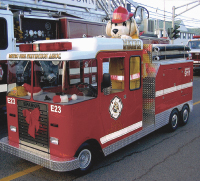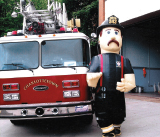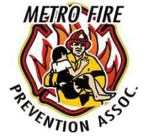
Features
Prevention
Better public education: Three P.E.I. departments deliver effective prevention message
Fire prevention education is an
important priority for all fire departments. But when it comes to
educational efforts, larger departments have more people and resources
available to do the job than their smaller counterparts.
July 18, 2008
By James Careless
Fire prevention education is an important priority for all fire departments. But when it comes to educational efforts, larger departments have more people and resources available to do the job than their smaller counterparts.
 |
| Photo courtesy Metro Fire Prevention Association The MFPA used fundraising dollars to build a miniature fire truck called Sparkin, which is a fixture in local parades. |
Mindful of this, P.E.I.’s Charlottetown, Crossroads and North Shore fire departments have banded together to form the Metro Fire Prevention Association (MFPA). By working together and sharing people and resources, they hope to provide better fire prevention education to their three jurisdictions than they could on their own.
“What we did was to get two reps from each station to join the MFPA committee, so that we could collectively design better and more efficient ways to deliver fire education,” says Cindy MacFadyen, the CFD’s fire prevention officer. “Our goal was clear: We wanted to raise fire-prevention education to a new level in our jurisdictions.”
To do this, the MFPA decided to get fire prevention out into the community both at public events and area schools. Here’s how they have done it.
Step one: Acquire impressive props
Mindful of how much people – especially children – like realistic props, the MFPA used money from its various fundraising campaigns to build a miniature fire truck called “Sparkn”. Built on a go-cart chassis, Sparkn gives kids “a chance to feel like they are riding in a real fire truck, but built to their size,” says CFD fire inspector Wynston Bryan. “They can even ride in the back and put on kid-sized turnout gear.” Besides turning up at community events and schools, Sparkn is regularly seen in local parades.
 |
| Photo courtesy Metro Fire Prevention Association The MFPA’s 10-foot inflatable firefighter stands out in a crowd. |
Freddie the fire dog is the MFPA’s second impressive educational device. Funded by the three fire departments, the Island Shriners, the general public and the MFPA, Freddie is an animated dog in a robotronic fire truck. He speaks, moves, listens, winks and can even play music thanks to a remote-control operated by an adult at a distance. Freddie has a knack for talking to children at their level and the mobility to glide down school hallways with ease. And yes: Freddie’s siren and warning lights work!
“Our last purchase was a 10-foot inflatable firefighter,” says Inspector Bryan. “He really stands out in a crowd!”
Step two: Reach the kids
Sparkn and Freddie the fire dog exist for one purpose – to communicate fire prevention knowledge to children. “Kids are like sponges, soaking up everything you give them,” McFadgen says. “In turn, they go home and make sure their homes are equipped with smoke alarms and escape plans. They really carry the Learn Not to Burn message straight to the parents and older siblings.”
MFPA volunteers reach kids wherever possible – in schools, at public fairs and parades, shopping malls – you name it.. Interactive materials such as a “hazard house” display in which kids can identify potential fire-causing threats are used to help kids understand the details of fire prevention.
The Metro Fire Prevention Association also teaches kids about establishing a meeting place where the family can gather after evacuating the home. The MFPA provides official meeting place decals for families to put up at these locations to make the meeting places clear and reinforce the idea in the kids’ minds.
 “You cannot overemphasize the importance of teaching children about fire prevention,” says MacFadyen. “This is why we work with McDonald’s during the semi-yearly changing of the clocks to promote the idea of changing smoke detector batteries at the same time. Kids get the message when they see us at their local McDonald’s and make sure their parents get it too.”
“You cannot overemphasize the importance of teaching children about fire prevention,” says MacFadyen. “This is why we work with McDonald’s during the semi-yearly changing of the clocks to promote the idea of changing smoke detector batteries at the same time. Kids get the message when they see us at their local McDonald’s and make sure their parents get it too.”
In a similar vein, each of the region’s three fire stations chooses a local child to serve as co-chief during the local Christmas parade. “We put their names on the side of the fire truck they are riding in,” Bryan says. “It really fires their imaginations!”
Beyond these efforts, the MFPA provides each school child with a fire prevention activity book just prior to Fire Prevention Week each October to get them thinking about fire safety. Finally, the MFPA gives a $1,000 bursary to a student whose chosen career lends itself to promoting fire safety. This year’s recipient is Melissa Driscoll, daughter of CFD firefighter Joe Driscoll. Now in her third year of university, Melissa is planning to become a teacher.
Results
The many activities staged by Charlottetown’s MFPA have raised public awareness of fire prevention. “It’s to the point that when kids see me in public, they call me ‘Sparkn’s mom,” laughs MacFadyen. But what is really impressive are the fire statistics from this area. Although statistics are not readily available because the amalgamation has changed the way the numbers are tabulated, MacFadyen says fire injuries are down substantially since 1995 as more families ensure that their homes have smoke alarms and escape plans.
“Part of our success is due to the quality of the education our volunteers deliver,” says Bryan. “We also ensure that every penny we raise in fundraising goes back into our communities. Not only does this maximize the educational capabilities that we have at hand, but it also plays well with the public.”
“We are very thorough in reaching the kids, with fire prevention programs crafted to meet the intellectual abilities and attention spans of each age group,” MacFadyen adds. “As they get older, the information we teach becomes more sophisticated. They are really our front line in the fight against fire injury and damage.”
“By joining together, our three fire departments are able to do far more in the area of fire prevention education than we could ever do separately,” Bryan concludes. “This is a lesson that other departments should heed: Combining resources can make a difference.”
Print this page
Advertisement
- RIT training: How to develop your department’s rapid intervention team
- Depression, like fire, takes many forms